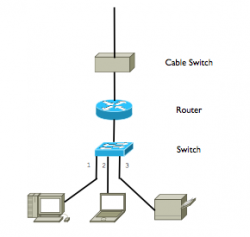I've been struggling with a cheap router for a while and I think it's time for an upgrade to something which functions more reliably and faster.
The confusion however is if I need a router or a switch and its speed capabilities. My setup consists of two Macs (soon 3), a networked printer and an IP-phone. All of this is connected to a cable-modem. My provider's download speed is 12 Mbps.
My current router is rated 10/100. Not sure if that means it can't handle anything above 10 Mbps, but it seems people are talking about Megabit routers these days, whatever that means. In any case I saw a huge difference in speed when connecting one of the Macs directly to the cable-modem compared to through the router. Not sure if that's because several devices are connected at once, but I doubt it as it's slow even if just one computer is turned on.
In addition to connecting to the Internet I also occasionaly transfer files between the computers, and each computer accesses the networked printer. All while the IP-phone adapter is on all the time of course. So what do I need -a router or a hub?
The confusion however is if I need a router or a switch and its speed capabilities. My setup consists of two Macs (soon 3), a networked printer and an IP-phone. All of this is connected to a cable-modem. My provider's download speed is 12 Mbps.
My current router is rated 10/100. Not sure if that means it can't handle anything above 10 Mbps, but it seems people are talking about Megabit routers these days, whatever that means. In any case I saw a huge difference in speed when connecting one of the Macs directly to the cable-modem compared to through the router. Not sure if that's because several devices are connected at once, but I doubt it as it's slow even if just one computer is turned on.
In addition to connecting to the Internet I also occasionaly transfer files between the computers, and each computer accesses the networked printer. All while the IP-phone adapter is on all the time of course. So what do I need -a router or a hub?


